![]()
![]()
![]()
Use LEFT and RIGHT arrow keys to navigate between flashcards;
Use UP and DOWN arrow keys to flip the card;
H to show hint;
A reads text to speech;
121 Cards in this Set
- Front
- Back
|
What are vertebrates defined by having?
|
dorsal support, such as a notochord or vertebral column—in other words, a backbone.
|
|
|
What are the characteristics of Phylum Chordata? (8 things)
|
1) Bilateral symmetry; segmented body; three germ layers; well-developed coelom
2) Notochord (a skeletal rod) present at some life stage 3) Single dorsal hollow nerve cord; anterior end of cord usually enlarged to form a brain 4) Pharyngeal pouches present at some life stage; in aquatic chordates these develop into pharyngeal slits 5) Endostyle in floor of pharynx or a thyroid gland derived from the endostyle 6) Postanal tail projecting beyond the anus at some life stage, which may or may not persist 7) Complete digestive system 8) Segmentation, if present, restricted to outer body wall, head and tail, and not extending into coelom |
|
|
What is the subphylum Urochordata sometimes known as?
|
Tunicata (also known as "sea squirts")
|
|
|
Which subphylum is sessile as an adult, but mobile is a larvae?
|
Urochordata (tunicata)
|
|
|
Which tunicates are entirely palagic?
|
Salps
|
|
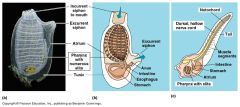
Which is the adult tunicate (urochordata), which is the larvae?
|

You can tell because of the tail and dorsal-hollow nerve chord.
|
|
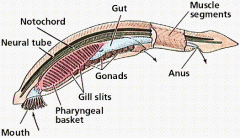
What is this animal known as?
|
Lancelet (or amphioxus). Subphylum cephalochordata.
|
|
|
Why are lancelets (amphioxus) important?
|
They have proved crucial in understanding the morphology and evolution of chordates in general -- including vertebrates.
|
|

What does the lancelet (amphioxus) have that identifies it as a chordate?
|
Dorsal-hollow nerve chord, supported by notochord, over 100 pharyngeal gill slits, a post-anal tail, and body is divided into myomeres (those w-shaped striations in muscles of fish)
|
|
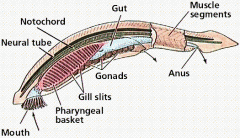
Why are cephalochordates (lancelets/amphioxus) not considered true vertebrates?
|
The brain is very small and poorly developed, sense organs are also poorly developed, and there are no true vertebrae.
|
|

Where is the wheel organ?
|
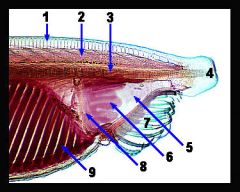
6.
Water is taken in through the mouth, drawn in by the beating of cilia located on the wheel organ, a set of ridges lying inside the mouth |
|

Where are the oral cirri?
|
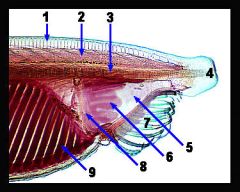
7.
The water is first filtered by the oral cirri, slender projections that surround the opening of the mouth. |
|

Where are the metapleural folds?
|

Water filtered by the oral cirri then passes through the gill slits. These gill slits are enclosed by folds of the body wall, the metapleural folds, to form a body cavity.
|
|

Where is the atrium?
|

(Labelled 'position of atrium)
Food particles in the water are trapped by mucus, while water passes through the slits and out of the atrium. |
|

Where is the atriopore?
|

Water passes through the atrium through the atriopore, located towards the posterior end
|
|
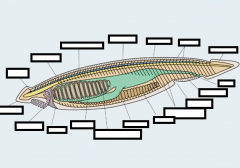
Where is the hepatic caecum?
|
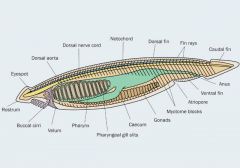
(Labelled caecum)
secretes digestive enzymes |
|
|
What does the iliocolonic ring do on cephalochordata (lancelets/amphioxus)?
|
actual digestion takes place in a specialized part of the intestine known as the iliocolonic ring
|
|
|
What is the cephalochordata (lancelet/amphioxus) extretory system composed of?
|
paired nephridia
|
|
|
Are the sexes seperate in male and female cephanlochordata (lancelet/amphioxus)?
|
Yes, both males and females have multiple paired gonads.
|
|
|
How are eggs fertalized in cephanlochordata (lancelet/amphioxus)?
|
Eggs are fertilized externally, and develop into free-swimming, fishlike larvae.
|
|
|
What is the scientific term for hagfish?
|
Class Myxini
(Hag mixing something in a bew) |
|
|
What is the scientific term for lampreys?
|
class Petromyzontida
(Petro, my son) |
|
|
What is the scientific term for cartilaginous fish?
|
class Chondrichthyes
(A shady shark conning people) |
|
|
What is the scientific term for boney fish?
|
class Actinopterygii
(Fish skeleton jogging in place) |
|
|
Why are hagfish not true eels?
|
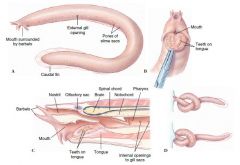
They lack a jaw, scales, paired fins and dorsal fin.
|
|
|
What is the hagfish skeleton made out of?
|
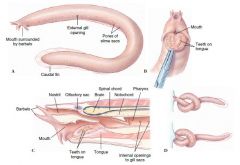
made up by of cartilage instead of bones and is limited to a notochord and the cartilaginous rays of the caudal fin
|
|

Cartilage is also used to strengthen these parts of the myxini (hagfish).
|
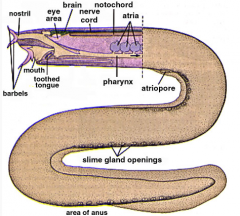
Tentacles (barbels), nasopharyngeal duct (toothed tongue), and soft palate (not shown).
|
|
|
Which organs on myxini (hagfish) are sheltered by capsules consisting of cartilage?
|
The labyrinth organ and the olfactory organ.
|
|
|
Why is the hagfish is unique among the non-extinct members of the phylum Chordata?
|
It has a partial cranium but no vertebrae
|
|
|
How does the hagfish differ from other vertebrates?
|
Has no cardiac innervation, no radial muscles, no eye lens and no extrinsic eye.
|
|
|
What is one of the anatomical features that characterizes the hagfish?
|
The duct leading from the esophagus to the exterior on the left side, only and opens behind the rearmost gill opening. This duct is called the oesophagocutaneous duct.
|
|
|
Myxini (hagfish) have 1-16 of these.
|
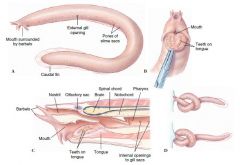
external gill openings
|
|
|
How does Myxini (hagfish) breath?
|
When the hagfish breathes, it draws in water through its nasopharyngeal duct instead of using its mouth. The nasopharyngeal duct opens at the anterior tip of the head and proceeds first to the median olfactory organ and then to the pharynx and gill pouches of the fish
|
|
|
What's the order of organs the water passes through in Myxini, when it's breathing?
|
1. nasopharyngeal duct
2. median olfactory organ 3. pharynx 4. gill pouches |
|
|
Where is the slime produced in myxini (hagfish)?
|
has mucous pores arranged in two ventrolateral lines. Each line consists of roughly 70-200 glands containing both mucous cells and thread cells.
|
|
|
What do the two ventrolateral lines in myxini (hagfish) contain?
|
Each line consists of roughly 70-200 glands containing both mucous cells and thread cells.
|
|
|
what is the only known vertebrate with body fluids isosomotic (same total osmotic pressure as seawater) with seawater?
|
hagfish
|
|
|
What is the class for lampreys?
|
Class Petromyzontida
(think of a lamp running on petrol) |
|
|
How do lampreys (Class Petromyzontida) resemble eels?
|
they have no scales, and can range anywhere from 13 to 100 centimetres long
|
|
|
What type of fins do lampreys (Class Petromyzontida) lack?
|
Paired
|
|
|
What are the lampreys (Class Petromyzontida) the sistertaxon of?
|
all living jawed vertebrates (gnathostomes)
|
|
|
how do Parasitic lampreys (Class Petromyzontida) feed?
|
by attaching their mouthparts to the target animal's body, then using their teeth to cut through surface tissues until they reach blood and body fluid.
((think of lampresy feeding on seal)) |
|
|
how do non-parasitic lampreys (Class Petromyzontida) feed?
|
Filter feeding.
Non-parasitic lampreys, which are usually freshwater species, do not feed as adults; they live off reserves acquired as ammocoetes, which they obtain through filter feeding. |
|
|
Which animals have become a plague in north american great lakes?
|
Sea lampreys (Class Petromyzontida), b/c artificial canals allowed their entry during the early 20th century.
They are considered an invasive species and have no natural enemies in the lakes |
|
|
How have efforts been made to control the invasive Sea lampreys (Class Petromyzontida) population in the great lakes?
|
special barriers to prevent the upstream movement of adults, or by the application of toxicants called lampricides, which are harmless to most other aquatic species.
However, those programs are complicated and expensive, and do not eradicate the lampreys from the lakes, but merely keep them in check. New programs are being developed, including the use of chemically sterilized male lampreys in a method akin to the sterile insect technique. Research currently under way on the use of pheromones and how they may be used to disrupt the life cycle has met with some success |
|

Ammocoete (sea lamprey larvae) is similar in structure to...
|
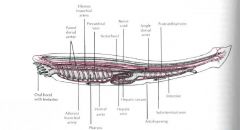
amphioxus (Lancelet larvae)
|
|
|
What class do the cartilaginous fish belong to?
|
The Chondrichtyhyes
|
|
|
What animals do the Chondrichtyhyes include?
|
cartilaginous fish
including the sharks, rays and skates |
|
|
what do Members of the Chondrichthyes all lack ?
|
true bone and have a skeleton made of cartilage
|
|
|
What is the only thing calcified in Chondrichthyes?
|
teeth
|
|
|
what are some Other characteristics of cartilaginous fishes?
|
jaws, paired fins, paired nostrils and a two-chambered heart
|
|
|
What is a "denticle" in class Chondrichthyes (cartilaginous fish)?
|
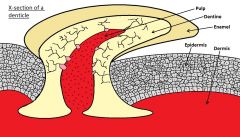
tooth-like scales
Denticle scales are similar to vertebrate teeth in structure. At the core of a dentical scale lies a pulp cavity that receives blood flow for nourishment. The pulp cavity is capped with a cone-shaped layer of dentine. The denticle sits on top of a basal plate which overlies the dermis. Each denticle is covered with an enamel-like substance |
|
|
are class Chondrichthyes (cartilaginous fish) carivorous?
|
Yes. and most species feed on live prey. There are some species that feed on the remains of dead animals and still others that are filter feeders.
|
|
|
What' different about the fins of Chondrichthyes (cartilaginous fish) ?
|
thick, fleshy fins, unlike bony fish.
|
|
|
What' different about the tails of Chondrichthyes (cartilaginous fish) ?
|
the tail is divided into two lobes, and the vertebrae extend into the upper lobe, which is elongated past the lower half. Such a tail is called heterocercal
|
|
|
what is a tails of Chondrichthyes (cartilaginous fish) called?
|
Heterocercal,
(different cer(VI)cal, verbetral column extends into one lobe of tail) Ceral. Think of a shark eating two different types of cereal with it's tail. |
|
|
what is the tails of ray-finned fish called?
|
homocercal (same ceral)
Think of a ray balancing a box of cereal on it's tail. |
|
|
What is the class for the lobe-finned fishes, (true bony fishes)?
|
Class Sarcopterygii
((think of a sarcophaus opening up to reveal a coelacanth)) |
|
|
How are Sarcopterygii (lobe-finned fishes or true bony fishes) distinguished?
|
distinguished by fins that differ from those of all other fish in that each is borne on a fleshy, lobelike, scaly stalk extending from the body
Can use these to walk, and it's thought that these fins are what evolved into legs of the first tetrapod land vertebrates, the amphibians. |
|
|
What is the ancestor of amphibians?
|
Sarcopterygii (lobe finned fish). B/C they're fins were thought to have evolved into legs.
|
|
|
What are the two species of Sarcopterygii (lobe finned/true bony fish) that still exist?
|
coelacanths and the lungfishes
|
|
|
What class is composed of the bony fish?
|
Class Actinopterygii
Think of a bony fish skeleton running on a treadmill) |
|
|
What's the most numerous and varied class of fish?
|
Class Actinopterygii
. Most of these fishes are a type called ray-finned fishes |
|
|
What is Class Actinopterygii (bony fish) mostly composed of?
|
ray-finned fishes
|
|
|
what aids in changing depth in the water, in Class Actinopterygii (bony fish)?
|
swim bladder
|
|
|
What did the swim bladder evolce into
|
primitive lung, with some fishes such as bowfins, gars and bichirs, still using it for breathing
Species of fish that do not possess a swim bladder sink to the bottom if they stop swimming. |
|
|
how does blood flow through the body of fish?
|
- The heart of a fish is a simple pump, and the blood flows through the chambers, including a nondivided atrium and ventricle, to the gills only.
Oxygenated blood leaves the gills and goes to the body proper |
|
|
What's the word for when fish feed on other fish?
|
piscivorous
(think 'pisces') |
|
|
How long are fish intestines of piscivorous fish?
|
fairly short intestines because such food is easy to chemically break down and digest
|
|
|
what's an example of a piscivorous fish?
|
bass
|
|
|
what's an example of a herbiviourus fish?
What is it's intestine like? |
tilapia
(think of it served with parsley or something) longer intestines because plant matter is usually tough and fibrous and more difficult to break down into usable components |
|
|
What's the purpose of the liver in fish?
|
to break down fats
also important in the destruction of old blood cells and in maintaining proper blood chemistry, as well as playing a role in nitrogen (waste) excretion. |
|
|
what is The function of the pyloric caeca in fish?
|
not entirely understood, but it is known to secrete enzymes that aid in digestion, may function to absorb digested food, or do both.
|
|
|
What do the endocrine glands of fish do?
|
release similar hormones to control development, growth, reproduction and other responses.
|
|
|
what is the 3rd eye in the fish endocrine system?
|
the PINEAL GLAND (is the 3rd eye) of fish and amphibians is located near the skin and functions to detect light. This is often referred to as the third eye
|
|
|
What does the kidneys in fish do?
|
The kidney filters liquid waste materials from the blood; these wastes are then passed out of the body. The kidney is also extremely important in regulating water and salt concentrations within the fish’s body, allowing certain fish species to exist in freshwater or saltwater, and in some cases both.
|
|
|
what is the primary structural framework upon which the fish’s body is built?
|
The spine
|
|
|
How do fish see?
|
Fish see through their eyes and can detect color
|
|
|
what is the fishes strongest sense?
|
smell
Paired nostrils, or nares, in fish are used to detect odors in water and can be quite sensitive. |
|
|
What does the lateral line in fish do?
|
The lateral line primarily senses water currents and pressure, and movement in the water.
|
|
|
What is the lateral line in fish?
|
The lateral line is a sensory organ consisting of fluid filled sacs with hair-like sensory apparatus that are open to the water through a series of pores (creating a line along the side of the fish).
|
|
|
how do fish reproduce generally?
|
sperm and eggs usually are shed into the water, where fertilization occurs. The zygote develops into a swimming larva that can fend for itself until it develops into the adult form.
|
|
|
how do fish breath?
|
Fishes breathe by means of gills, respiratory organs that are kept continuously moist by the passage of water through the mouth and out the gill slits. As the water passes over the gills, oxygen is absorbed by blood and carbon dioxide is given off.
Water passes over gills, gas exchange happens, O2 is absorbed by blood, and CO2 given off. |
|
|
what is considered the sister group to all other extant ray-finned fishes?
|
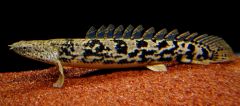
Bichirs
|
|
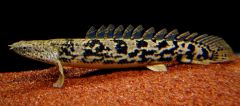
What is the subclass for birchirs?
|
Subclass Cladistia
|
|
|
what is the dorsal fin of the birchir set up like?
|
instead of a single dorsal fin, vary in number from seven to 18.
Each of the dorsal finlets has bifid (double-edged) tips, and are the only fins with spines; the rest of the fins are composed of soft rays. |
|
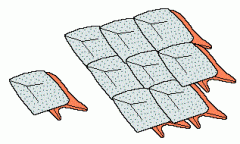
what are trapezoidal scales called?
|
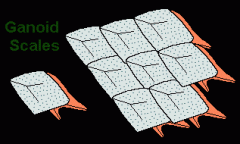
ganoid
|
|
|
what primitive characteristics do birchirs (subclass cladistia) have?
|
fleshy pectoral fins superficially similar to those of lobe-finned fishes.
They also have a pair of slit-like spiracles used to exhale air, two gular plates, and paired ventral lungs (the left lung shorter than the right). Four pairs of gill arches are present. |
|
|
What subclass do the paddlefish and sturgeon belong to?
|
Subclass Chondrostei
|
|
|
what is the Subclass Chondrostei (paddlefish and sturgeon) skeleton like?
|
primarily cartilaginous
their caudal fins heterocercal (vertebrae extends into one lobe of tail, making it longer) |
|
|
What is a heterocercal tail in fish?
|
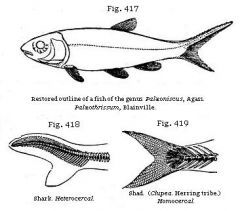
vertebrae extends into one lobe of tail, making it longer
|
|
|
Why is the ossification of the skeleton in Subclass Chondrostei (paddlefish and sturgeon) thought to be delayed?
|
because it's found in elderly fish
|
|
|
how are Chondrostei (paddlefish and sturgeon) similar physiologically to sharks?
|
lack bone, the structure of the jaw is more akin to that of sharks than other bony fish, and both lack scales
Additional shared features include spiracles and, in sturgeons, a heterocercal tail (the vertebrae extend into the larger lobe of the caudal fin). |
|
|
what is the largest and most diverse of the subclasses of bony fish?
|
The subclass neopterygii
with about 25000 species in both fresh and marine environments |
|
|
what are the neopterygii skeletons like?
|
Their skeletons are primarily boney, and their caudal fins homocercal.
|
|
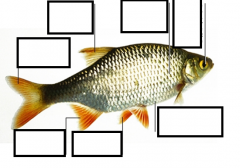
in neopterygii (perch), where is the operculum?
|
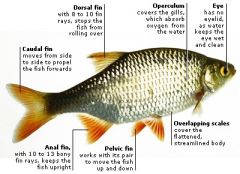
The opercula cover & protect the gills
((gills are underneath opercula)) |
|
|
What makes up the gills in neopterygii (perch)?
|
gill slits or spaces between the gills.
cartilage support called the gill arch and the soft gill filaments |
|
|
what is the subclass for perch?
|
neopterygii
Think of a neopet eating a perch. |
|
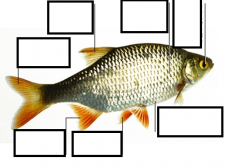
Observe the different fins on the perch. Locate the pectoral, dorsal, pelvic, anal, and caudal fins. Note whether the fin has spines.
|

*pectoral fins are little ones at the front, under the gills
|
|

in neopterygii (perch), where is the anus located?
|
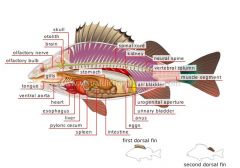
. In the female, the anus is in front of the genital pore, and the urinary pore is located behind the genital pore. The male has only one pore (urogenital pore) behind the anus.
|
|
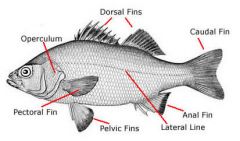
What is the lateral line on perch? (neopterygii )
|

|
|
|
how can you tell the age of a fish?
|
count the growth rings on its scales by using a microscope.
One ring = one year growth |
|
|
what types of scales do Cartilaginous fish have ?
|

placoid scales
|
|
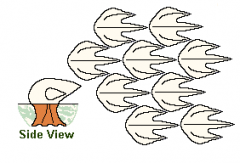
What type of scales are these?
|
placoid, belongs to cartilaginous fish
|
|
|
what types of scales do cladistia fish have ?
|
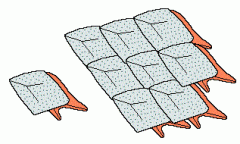
ganoid scales
|
|
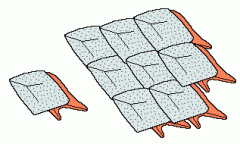
What type of scales are these?
|
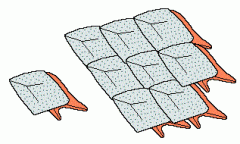
Ganoid
belongs to cladistia (birchirs) |
|
|
neoptergians have what type of scales?
|

either cycloid or ctenoid scales
|
|
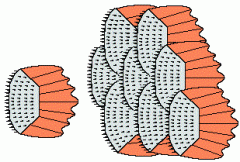
What type of scales are these?
|
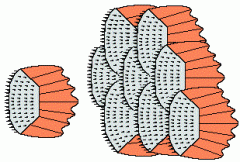
Ctenoid
neoptergians |
|
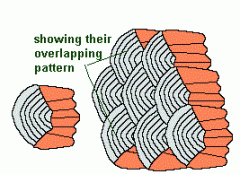
What type of scales are these?
|
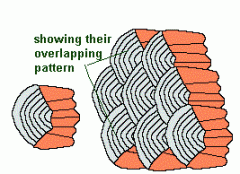
cycloid
neoptergians |
|
|
what is the caudel end of a fish?
|
tail end
|
|

Where's the liver in the perch (Subclass Neopterygii)?
|
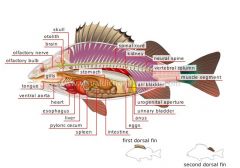
|
|
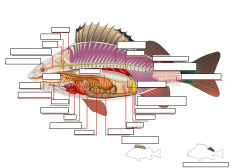
Where's the esophagus in the perch (Subclass Neopterygii)?
|
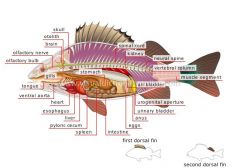
It's short, indicating what types of food it eats.
Perhaps piscivorous |
|

Where is the spleen in the perch (Subclass Neopterygii)?
|

near the stomach
|
|
|
How many chambers does the heart of a fish have?
|
2. an atrium & and a ventricle
|
|
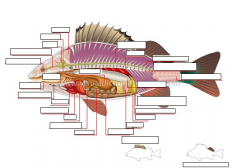
Where is the heart in the perch (Subclass Neopterygii)?
|
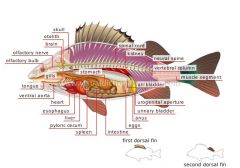
|
|
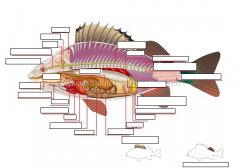
Where is the swim bladder in the perch (Subclass Neopterygii)?
|
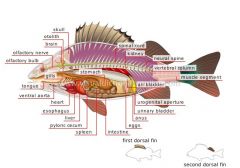
(labelled 'air bladder' in pic)
This sac has a thin wall and gives the fish buoyancy. |
|
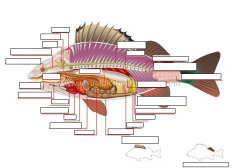
Where is the kidneys in the perch (Subclass Neopterygii)?
|
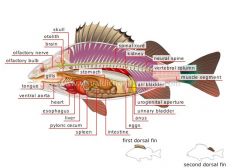
These filter wastes from the blood. Wastes exit the body through the vent located on the ventral side of the perch.
|
|
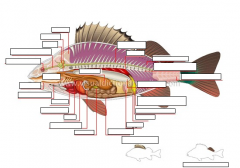
where are the gonads in the perch (Subclass Neopterygii)?
|
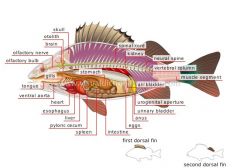
Below the swim bladder are the gonads, testes or ovaries. In a female, these may be filled with eggs
|
|
|
what are myomeres?
|
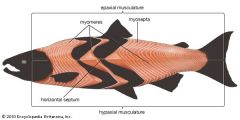
the zigzag bands on fish muscle
This shape gives the fish more power and finer control over its movements, since many myomeres are involved in bending a given segment of the body. |
|
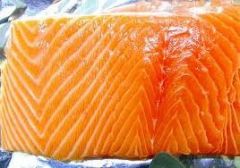
what are these?
|
myomeres (zigzag bands on fish muscle)
|
|
|
what is the purpose of myomeres in fish?
|
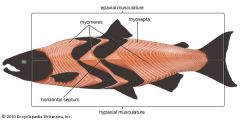
These muscles form part of the fish's propulsive mechanism. The muscles are arranged in zigzag bands called myomeres. This shape gives the fish more power and finer control over its movements, since many myomeres are involved in bending a given segment of the body.
|

